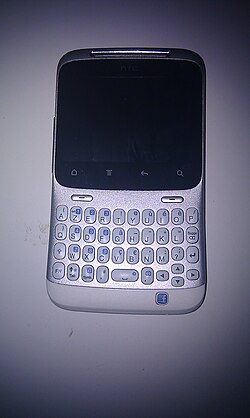This article needs additional citations for verification .(March 2017) |
 HTC ChaCha with a physical French AZERTY keyboard | |
| Manufacturer | HTC |
|---|---|
| First released | June 2011 |
| Successor | HTC First |
| Compatible networks | AT&T |
| Dimensions | 114.4×64.6×10.7 mm (4.50×2.54×0.42 in) |
| Weight | 124 g (4.37 oz) with battery |
| Operating system | Android 2.3 Gingerbread |
| CPU | 800MHz Qualcomm Snapdragon MSM7227 processor (ARMv6) |
| Memory | 512 MB of RAM |
| Storage | microSD support |
| Battery | Li-ion 1250 mAh |
| Rear camera | 5-megapixel camera |
| Display | 66 mm (2.6") Touchscreen 480x320 px |
| Connectivity | HSDPA/HSUPA, Wi-Fi(IEEE 802.11b/g/n) |
| Website | Official website |
The HTC ChaCha (also known as the HTC ChaChaCha in Spanish-speaking countries or the HTC Status in the US and Canada) is an Android smartphone that was announced by HTC in February 2011 at the Mobile World Congress, alongside its sister phone, the HTC Salsa.
Contents
The ChaCha is primarily designed for text messaging, and also features tight integration with the social network Facebook, which includes a dedicated Facebook button below its keyboard which allows users to quickly share content on the service. [1]